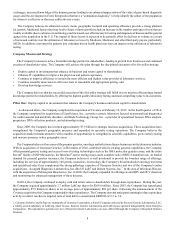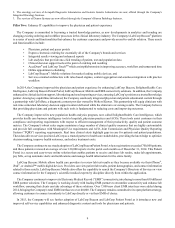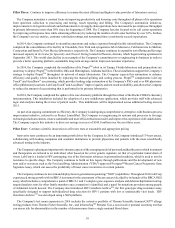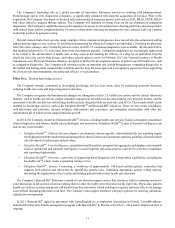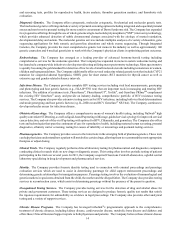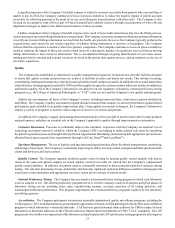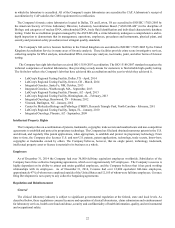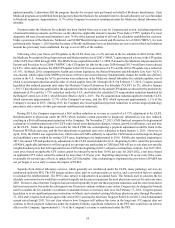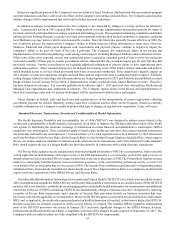LabCorp 2014 Annual Report Download - page 17
Download and view the complete annual report
Please find page 17 of the 2014 LabCorp annual report below. You can navigate through the pages in the report by either clicking on the pages listed below, or by using the keyword search tool below to find specific information within the annual report.15
programs represent potential significant savings to the health care system by increasing the detection of early-stage diseases
and effectively managing chronic disease conditions.
Development of New Tests
Advances in medicine continue to fundamentally change diagnostic testing, and new tests are allowing clinical laboratories
to provide unprecedented amounts of health-related information to physicians and patients. New molecular diagnostic tests that
have been introduced over the past several years, including a gene-based test for human papillomavirus, HIV drug resistance
assays, and molecular genetic testing for cystic fibrosis, have now become part of standard clinical practice. The Company
continued its industry leadership in gene-based and esoteric testing in 2014, generating $2.0 billion in revenue. As science
continues to advance, the Company expects new testing technologies to emerge; therefore, it intends to continue to invest in
advanced testing capabilities so that it can remain on the cutting edge of diagnostic laboratory testing. The Company has added,
and expects to continue to add, new testing technologies and capabilities through a combination of internal development initiatives,
technology licensing and partnership transactions and selected business acquisitions. Through its national sales force, the Company
rapidly introduces new testing technologies to physician customers. This differentiation is important in the retention and growth
of business.
In 2014, the Company continued its emphasis on scientific vision and leadership with the introduction of 174 significant test
menu and automation enhancements. The Company is focused on the expansion of existing programs in molecular diagnostics
as well as the introduction of new assay and assay platforms through licensing partnerships, acquisitions and internal development.
Evidence of the commitment to the development of new diagnostics and applications for those diagnostics was provided in the
more than 148 scientific publications (articles, book chapters, books and abstracts) and presentations at scientific meetings
authored by the Company's scientific team in 2014. Examples of new tests and services introduced in 2014 include:
Cardiovascular Disease Risk Assessment - The Company acquired LipoScience and is now able to provide in-house testing
for NMR LDL-particles, an advanced method for the assessment of cardiovascular risk.
Infectious Diseases - The Company launched GenoSure ArchiveSM the first laboratory test to help optimize antiretroviral
(ARV) drug regimens in virally suppressed HIV patients.
Breast Cancer Tests - The Company transitioned its suite of BRCA 1/2 tests which identify gene mutations or alternations
that signal an increased risk for several specific types of cancer, including breast cancer and ovarian cancer to next generation
testing. Additionally, during 2014 the Company was one of the first to launch the Prosigna™ Breast Cancer Prognostic Gene
Signature Assay, an FDA approved breast cancer prognostic 50 gene signature assay developed by NanoString® Technologies,
Inc. ProsignaTM provides a risk category and a numerical score to assess the probability of breast cancer recurrence in certain
female breast cancer patients and provides physicians and their patients a new and important diagnostic tool, in conjunction
with other clinical and pathological factors, to help monitor and treat breast cancer recurrence. For postmenopausal female
breast cancer patients who have undergone surgery in conjunction with locoregional treatment, ProsignaTM’s assessment of
recurrence can be a useful tool in conjunction with other clinical and pathological factors to help guide treatment and monitoring
strategies.
Coagulation - The Company introduced a mass spectroscopy based method serotonin release assay. This assay is important
for diagnosing heparin-induced thrombocytopenia and is the first non-radio labeled assay to be offered for such testing.
Obstetrics and Gynecology - In 2014 the Company launched the informaSeqSM Prenatal Test. This test is an advanced, non-
invasive, next-generation prenatal screening test that can assess risk for multiple fetal chromosomal aneuploidies, or
abnormalities in the number of chromosomes, from a single maternal blood draw.
Genomic Testing - The Company introduced ExomeRevealSM, a whole exome sequencing testing service. Increasing evidence
suggests that early genetic diagnosis can improve clinical outcomes, and ExomeRevealSM will provide genome-wide
interpretation for children with serious childhood genetic diseases as well as additional diagnostic information for patients of
any age.
The Company continues its collaboration with university, hospital and academic institutions such as Duke University, The
Johns Hopkins University, the University of Minnesota and Yale University to license and commercialize new diagnostic tests.





